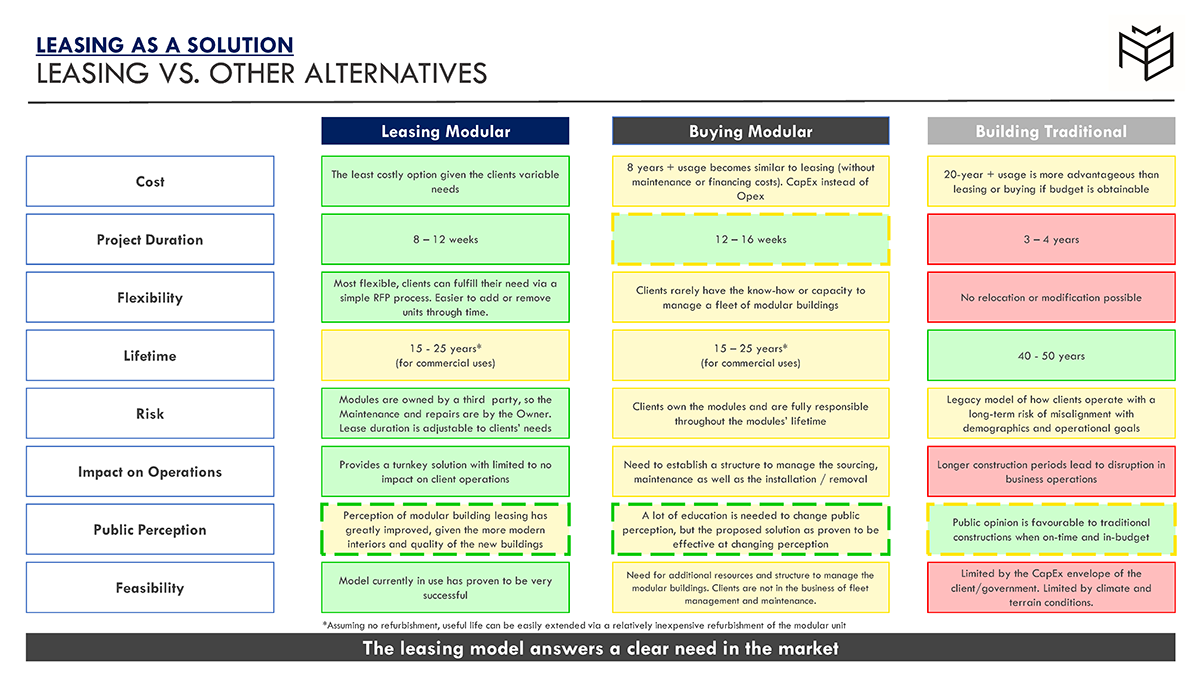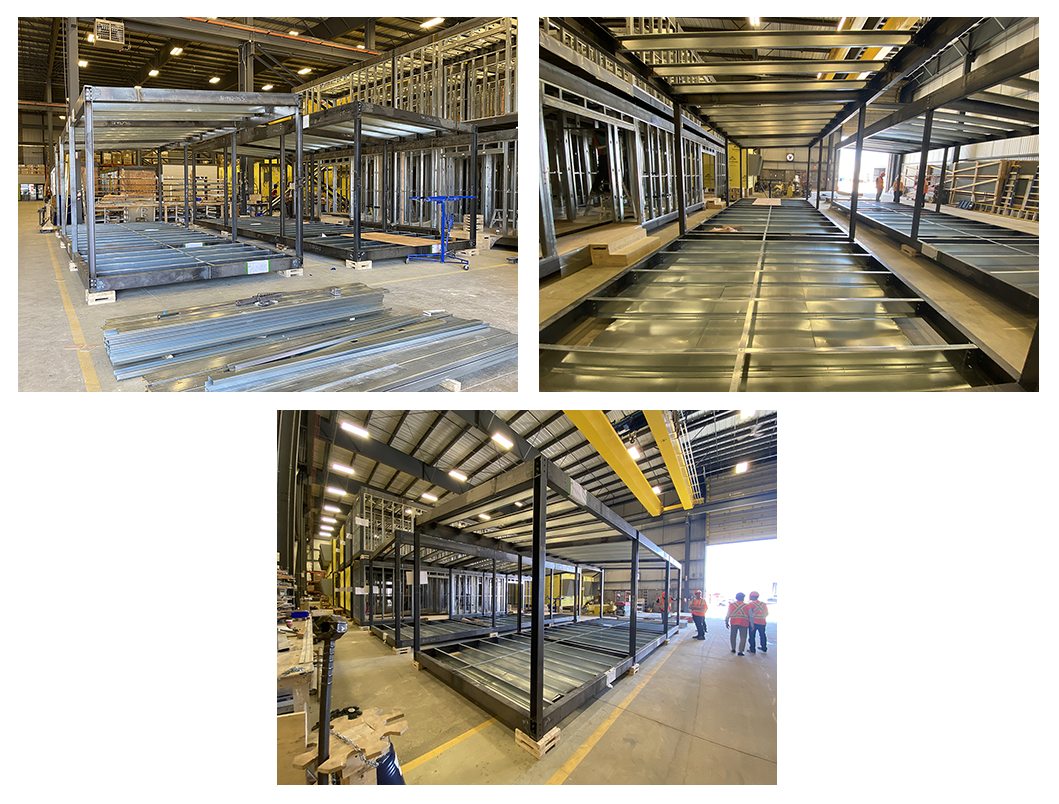Advantages of Modular Construction: Sustainability, Cost, and Time Efficiency
Modular construction has emerged as a superior alternative to traditional construction methods, particularly regarding sustainability, cost savings, and time efficiency. Here’s a closer look at how these two approaches compare.
Sustainability: A Greener Approach
- Energy Efficiency: According to the UK-based organization, The Waste and Resources Action Programme (WARP), modular buildings consume up to 67% less energy due to the efficiencies achieved in a factory setting.[3]
- Waste Reduction: According to the Modular Building Institute, modular construction can reduce materials usage by up to 90%, mainly eliminating waste through precise manufacturing processes.[4]
- Circular Economy: Modular construction methods support a circular economy model by allowing structures to be disassembled and reused, further minimizing environmental impact. This circular methodology ensures that modular buildings contribute to sustainable practices by adhering to building codes and standards, offering adaptability and enduring functionality like permanent construction.[5]
Modular construction stands out for its impressive sustainability practices. Constructed in a controlled factory environment, modular buildings significantly reduce materials usage, energy consumption, and waste generation compared to traditional methods.
Standards such as CSA Z782 and Z783 promote material recovery and reuse, bolstering modular construction’s environmental benefits. The Modular Building Institute regularly conducts sustainability studies, showcasing environmental benefits and driving industry innovation.[6]
Cost Savings: Financial Advantages
“Customers can expect cost savings ranging typically from 5-30% due to the predictability of project costs, reduced likelihood of unexpected expenses, shorter construction schedules, cheaper insurance, and the efficient use of materials.”
– Peter Schoettle, Director of Sales and Service, BECC Modular
-
- Here’s a snapshot of various cost-saving factors:
- Predictable Project Costs: Modular construction’s controlled environment leads to fewer unexpected expenses and more accurate budgeting.
- Shorter Construction Schedules: Reduced construction timelines result in lower labour costs and quicker return on investment.
- Efficient Use of Materials: Factory-based production minimizes material waste, contributing to overall cost savings.
Leasing options for modular buildings also provide a flexible and cost-effective solution for temporary needs, further reducing operational expenses instead of capital expenses compared to traditional methods.
“Leasing modular classrooms is a great way to address cost while providing the necessary flexibility. In terms of risk, it’s the least when you’re leasing modular because you’re not owning the module.”
– Philippe Latreille, Copresident, AMB Modular

Additionally, in Ontario, the removal of the provincial portion of the Harmonized Sales Tax (HST) on qualifying new purpose-built rental housing can lead to cost savings for qualifying projects.[7]
Time Efficiency: Speed and Precision
“One of the greatest benefits of modular construction in the education sector is the reduction of schedule and hazards associated with construction, especially on existing occupied sites such as schools. Moving construction activities off-site improves safety and reduces disruption on campus.”
– Chris Smith, Director of Sales – East, NRB Modular
Traditional school construction projects often take four to seven years from design to completion. They span multiple seasons and are susceptible to weather-related delays. On-site coordination issues and material/labour availability further extend completion times, posing challenges to timely project delivery.
One of the most significant advantages of modular construction is its ability to reduce project timelines drastically:
- Faster Completion: Projects can be completed 30-50% faster than traditional construction, often within three to six months.
- Concurrent Processes: Off-site module fabrication and on-site preparation occur simultaneously, minimizing delays.
- Weather Independence: Controlled factory environments eliminate weather-related disruptions, ensuring consistent progress year-round.
Arriving almost fully assembled, modules expedite on-site assembly, ensuring efficient progress even in challenging environments with quick installation. This expedited timeline speeds up occupancy and reduces disruption in existing facilities, such as schools and hospitals.
BECC Modular illustrates the difference between traditional and modular construction project timelines below:

Durability and Longevity
- To ensure the durability and longevity of modular constructions, supplier partners adopt a comprehensive approach. This includes:
- Adherence to CSA certification standards like CSA-A277, ensuring the use of high-quality materials that surpass traditional construction standards.
- Use of high-quality, durable materials, such as hard-shelled exteriors, marine-grade aluminum, and certified recycled steel, for structural integrity and reduced maintenance costs.
- Implementing rigorous quality control processes in factory settings to ensure precise construction and compliance with building codes, minimize errors, and enhance durability.
- Making design considerations that account for transport and installation stress to maintain structural integrity post-assembly and conducting regular inspections and tailored maintenance strategies to ensure long-term durability.
- Prioritizing reusable designs with high life expectancy to enhance overall durability and sustainability.

Risk Mitigation: Ensuring Success
Effective risk mitigation strategies are crucial to the success of modular building projects. These include:
- Comprehensive Planning: Involving stakeholders early to minimize costly changes.
- Quality Control: Factory settings ensure modules meet standards before transportation.
- Safe Working Environment: Off-site construction reduces worker exposure to hazardous conditions.
These strategies collectively enhance project efficiency and minimize potential risks throughout the modular construction process.
[3] https://nrbmodular.dexterra.com/blog/the-sustainable-benefits-of-modular-construction/
[4] https://www.modular.org/2023/12/26/how-modular-construction-leads-to-zero-waste-and-eco-fficiency/
[5] https://www.canadianarchitect.com/adwire-post/page/6749/
[6] https://mbimodularbuildinginstitute.growthzoneapp.com/ap/CloudFile/Download/LwYRWRzp
[7] https://news.ontario.ca/en/release/1003722/ontario-helping-to-build-more-rental-housing
